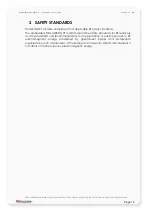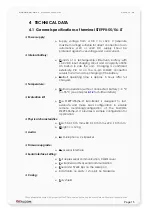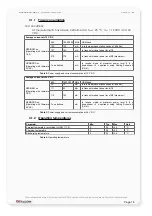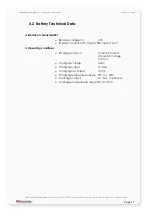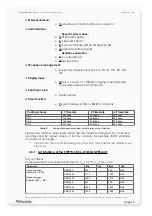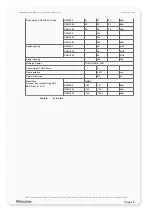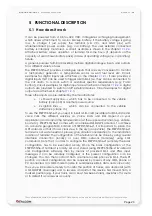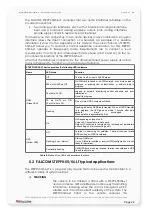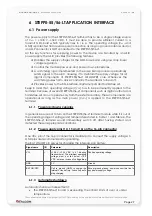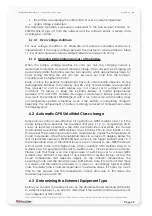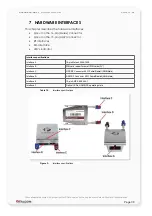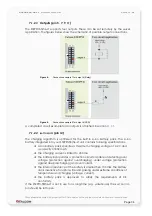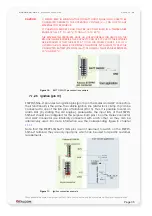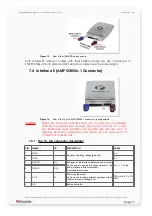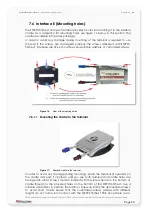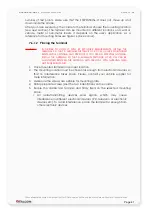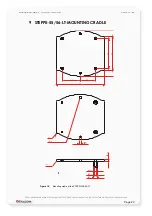
STEPPII-55/56-LT H
ARDWARE
DESCRIPTION
V
ERSION
1.01
•
the battery is exceeding the critical limits of over or under temperature.
•
under voltage is detected.
The automatic shutdown procedure is equivalent to the power-down initiated, i.e.
STEPPII-55/56-LT logs off from the network and the software enters a secure state
avoiding loss of data.
6.1.3.1 Over voltage shutdown
For over voltage conditions, no hardware and software controlled shutdown is
implemented. If the supply voltage exceeds the maximum value specified in Table
11, loss of data and even unrecoverable hardware damage can occur.
6.1.4 Charging & Discharging process of the battery
When the battery voltage reaches 4.2 volts per cell, the charging current is
decreased to maintain a constant terminal voltage of 4.2 volts per cell. Charging will
be terminated after the battery reaches full capacity, which approximately takes 5-7
hours. During this time the unit can also be used, but note that, the battery’s
capacity must be higher then 3.8 V.
Keep in mind, the extreme temperatures have an unfavourable influence on the
rechargeable batteries. The capacity and life cycle of the batteries are reduced if
they are kept at cold or warm places, e.g. in a closed car at summer or winter
conditions. Try always to keep the included battery at normal temperatures
between 10°C and 25°C. Outside this range, a decrease in battery performance
may result. The terminals STEPPII-55/56-LT with a too cold or too warm battery does
not temporarily operate sometimes, even if the battery is completely charged.
Especially, the achievement of battery is strongly reduced at temperatures under
the freezing point.
6.2 Automatic GPRS Multislot Class change
Temperature control is also effective for operation in GPRS Multislot class 10. If the
board temperature exceeds the specified limit (
for temperature limits
known as restricted operation
) while data are transmitted over GPRS, the module
automatically reverts from GPRS Multislot class 10 (3 RX x 2 TX) to class 8 (4 RX x 1 TX).
This reduces the power consumption and, consequently, causes the temperature of
board to decrease. Once the temperature drops to a value of 5 degrees below the
limit of restricted operation, STEPPII-55/56-LT returns to the higher Multislot class 10. If
the temperature stays at the critical level or even continues to rise, STEPPII-55/56-LT
will not switch back to the higher class. After a transition from Multislot class 10 to
Multislot class 8 a possible switchback to Multislot class 10 is blocked for one minute.
Please, note that there is no one single cause of switching over to a lower GPRS
Multislot class. Rather it is the result of an interaction of several factors, such as the
board temperature that depends largely on the ambient temperature, the
operating mode and the transmit power. Furthermore, take into account that there
is a delay until the network proceeds to a lower or, accordingly, higher Multislot
class. The delay time is network dependent. In extreme cases, if it takes too much
time for the network and the temperature cannot drop due to this delay, the
terminal may even switch off.
6.3 Determining the External Equipment Type
Before you connect the serial port pins on the aforementioned terminals (DCE units)
to external equipment, you need to determine if the external hardware serial ports
are configured as DTE or DCE.
This confidential document is a property of FALCOM and may not be copied or circulated without previous permission
.
Page 28

